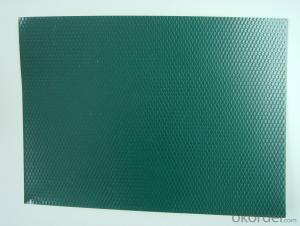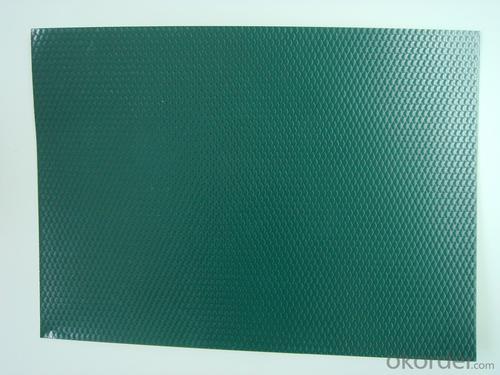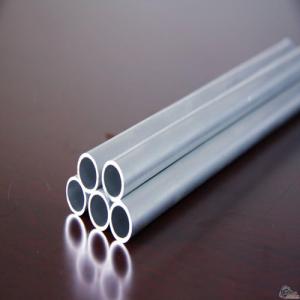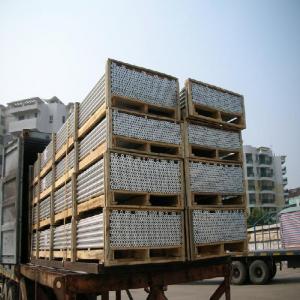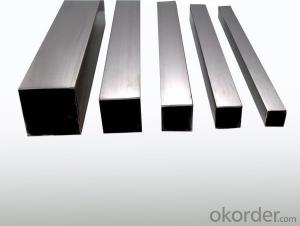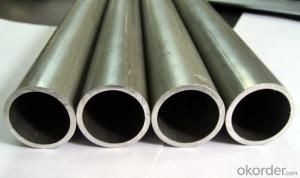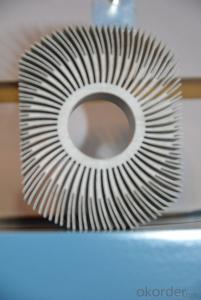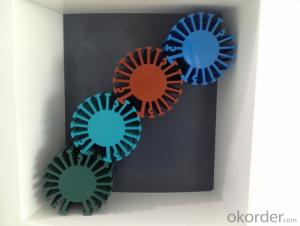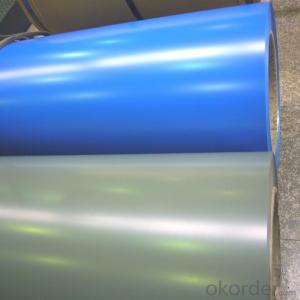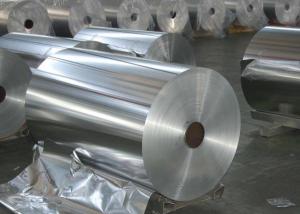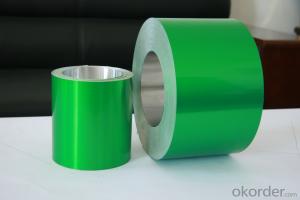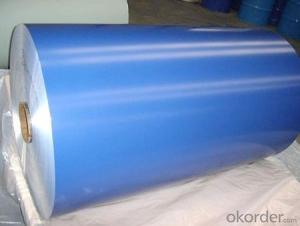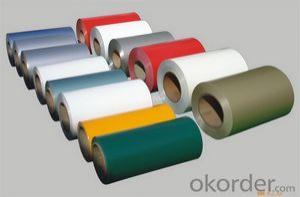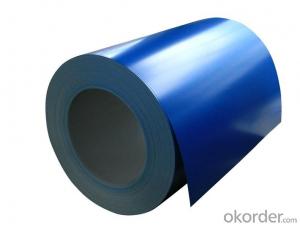Coated Aluminum Coil-AA3003 for Aluminum Pipes
- Loading Port:
- China Main Port
- Payment Terms:
- TT OR LC
- Min Order Qty:
- -
- Supply Capability:
- -
OKorder Service Pledge
OKorder Financial Service
You Might Also Like
1.General Information of Color Coated Aluminium Coil with Competitive Prices
Aluminum coil is between 0.1 mm and 500mm in thickness and has a wide variety of uses in the construction industry including aluminium siding and roofing. Sheet is also used widely in construction, decoration, transport applications and other various industrial filed, such as automobile body panels, airframes, curtain walls and the hulls of boats etc.
Alloy | AA1050,AA1060, AA1070, AA1100, AA3003, AA3004, AA3005, AA3105, AA5005, AA5052, AA5754, AA5083, AA8011 |
Temper: | H12, H14, H16, H18, H22, H24, H26, H32,HO, F |
Thickness: | 0.10-4.0mm |
Width: | 10mm- 2000mm |
Coating | PE(Polyester) |
Painting Thickness | Standard 16-25 microns, max 40 microns |
Color | Acording to Ral colors or customer’s samples |
Standard: | GB/T17748-1999, ASTM, ISO, EU standard |
Special Specification is available on customer’s requirement | |
PE(polyester) Coating
PE(polyester) coating:high molecular polymer as monomer and addition of alkyd, is an UV-resistant coating. It can be classified matt and glossy according to coating gloss. The compact molecule structure, makes paint surface luster and smooth,which assure good printing on the panel surface. With an warranty of 8-10 years for weather resistance, it is specially applied for internal decoration and sign board.
2 Usage/Applications of PE Coated Aluminum Coil/Sheet
Our company's PE Coated Aluminum Coil/Sheet have been widely used in the fields of construction and decoration(garage doors, ceiling etc.), electronic appliances, lighting decoration, air-condition air pipe, sanwich panels and drainage, etc.
- Q: The company has an aluminum product with high precision (less than 0.1mm). Aluminum profiles manufacturers can do so to achieve this accuracy. However, when the oxidation of the problem, the oxidation process, due to various reasons, there will be repeated rework, repeated oxidation phenomenon.. There is an aluminum oxide 3 times, even after the small 0.06mm. More exaggeration is that there is a small number of aluminum parts, the number of oxidation is five or six times, directly leading to size coordination, delivery, affecting the use of products. The other side also said it is difficult to control the number of oxidation, can not avoid repeated oxidation phenomenon.. Is it really oxidation that leads to smaller size? What's the solution?
- Of course, the oxidation will become smaller, the oxidation time to be washed by alkali, aluminum meets alkali will react chemically, some of the aluminum will be dissolved. When the aluminum extrusions are extruded before oxidation, the allowance should be included. If the finished product is aluminum rod 10mm its tolerance is +0.10mm, if you need an oxidation in the extrusion, the time should be under the control of the product median +0.02mm is 10.07, the oxidation is 10.05 aluminum rods, of course also need to consider the need to straighten out after the extrusion process, will pull a few small silk. If you really need multiple oxidation, as you say, to shrink 0.06mm, then the size should be controlled after extrusion: the median value of the product is +0.06mm.
- Q: Can aluminum pipes be used for irrigation valves?
- Yes, aluminum pipes can be used for irrigation valves. Aluminum is a durable and lightweight material that is resistant to corrosion, making it suitable for irrigation systems.
- Q: How do aluminum pipes compare to HDPE pipes in terms of flexibility?
- Aluminum pipes and HDPE pipes differ in terms of flexibility. HDPE pipes are known for their high flexibility due to the nature of the material they are made from. High-density polyethylene (HDPE) is a thermoplastic polymer that possesses a high degree of elasticity and flexibility. This allows HDPE pipes to be easily bent, twisted, and maneuvered around obstacles during installation. On the other hand, aluminum pipes are generally less flexible compared to HDPE pipes. Aluminum is a metal that has a higher rigidity and stiffness compared to HDPE. This means that aluminum pipes are less able to bend or flex without sustaining damage or deformation. They are better suited for applications that require more structural integrity and rigidity, such as in industrial or heavy-duty environments. While aluminum pipes may not be as flexible as HDPE pipes, they offer other advantages such as higher strength, corrosion resistance, and the ability to handle higher pressure and temperature conditions. The choice between aluminum and HDPE pipes should be based on the specific requirements of the project, considering factors such as flexibility, strength, durability, and the environment in which they will be used.
- Q: How to handle the surface of the aluminum tube is bright, and will not have any impression after touching it
- Can be anodized by bright aluminum to meet your requirements.
- Q: What are the different insulation options for aluminum pipes?
- There are several insulation options available for aluminum pipes. One of the most common options is fiberglass insulation. This type of insulation is made of small fibers of glass that are woven together to create a blanket-like material. Fiberglass insulation is effective at reducing heat loss or gain in aluminum pipes and is relatively inexpensive. Another option is foam insulation, which is typically made of closed-cell or open-cell foam. Closed-cell foam insulation is denser and provides better thermal insulation, while open-cell foam is more lightweight and flexible. Foam insulation is easy to install and provides good protection against condensation and heat transfer. Another alternative is elastomeric insulation. Elastomeric insulation is made of synthetic rubber and is commonly used for pipes that carry chilled or hot water. It is flexible, easy to install, and has excellent thermal insulation properties. Elastomeric insulation is also resistant to UV radiation and moisture, making it suitable for outdoor applications. Additionally, reflective insulation can be used for aluminum pipes. Reflective insulation consists of a layer of aluminum foil that is attached to a backing material. This type of insulation reflects radiant heat away from the pipe, reducing heat gain or loss. Reflective insulation is lightweight, easy to install, and can be used in both indoor and outdoor applications. Finally, there are also mineral wool and ceramic fiber insulation options available for aluminum pipes. Mineral wool insulation is made of natural or synthetic fibers and provides good thermal and acoustic insulation. Ceramic fiber insulation is made of high-temperature materials and is suitable for pipes that carry extremely hot substances. Ultimately, the choice of insulation for aluminum pipes depends on factors such as the desired level of thermal protection, the environment in which the pipes are located, and the specific requirements of the application. It is important to consider these factors and consult with professionals to determine the most suitable insulation option for aluminum pipes.
- Q: What material can be used for welding aluminum copper tube?
- Generality:Universal 51 has the remarkable ability to weld all white metals. White metal includes zinc (almost impossible to solder), copper lead alloy, tin lead alloy, aluminum and lead, etc.. Universal 51 can also be any of the above types of metal and copper, brass, steel, stainless steel or bronze and any other metal welding.Universal 51 flux:The soldering flux is made of white metal and will not corrode. It destroys the oxide layer and helps the universal 51 free flow. In this way, the electrode will completely wet and penetrate the surface of the base metal to form a smooth and strong welding layer.Simplify the welding and maintenance of zinc die castings:For a long time, people think that zinc die castings with ordinary electrode can not be welded, because can cause zinc die castings sagging and collapses before welding. To achieve the best results, use universal 51 time to use universal 51 flux.
- Q: Can aluminum pipes be bent or shaped easily?
- Yes, aluminum pipes can be bent or shaped easily. Aluminum is known for its malleability, which means it can be easily shaped or formed without cracking or breaking. This characteristic makes aluminum pipes a popular choice in various applications where flexibility is required. Aluminum pipes can be bent using a variety of methods such as cold bending, rotary draw bending, or heat induction bending. Additionally, they can also be shaped through processes like extrusion or rolling. The ease with which aluminum pipes can be bent or shaped makes them a versatile option in industries such as construction, automotive, and aerospace.
- Q: What are the different sizes of aluminum pipes available?
- There is a wide range of sizes for aluminum pipes to accommodate various needs and uses. The diameters of aluminum pipes typically span from 1/8 inch to 12 inches. These pipes are offered in different wall thicknesses, which can impact their overall strength and durability. Furthermore, aluminum pipes can be obtained in varying lengths, such as 10 feet or 20 feet, depending on the supplier and specific demands. It is crucial to mention that the availability of sizes may differ depending on the supplier or manufacturer, so it is advisable to consult them for the specific sizes they provide.
- Q: What are the different joining methods for aluminum pipes?
- There are several different joining methods for aluminum pipes, each with their own advantages and applications. 1. Welding: This is the most common method for joining aluminum pipes. It involves melting the edges of the pipes and fusing them together using heat and a filler material. TIG (Tungsten Inert Gas) welding and MIG (Metal Inert Gas) welding are commonly used techniques for aluminum pipe welding. Welding provides a strong and durable joint, but it requires skilled labor and specialized equipment. 2. Mechanical joining: Mechanical joining methods include techniques like flanging, threading, and compression fittings. Flanging involves creating a flange on the end of the pipe and using bolts or screws to connect it to another flange. Threading is done by cutting threads on the pipe ends and using threaded connectors to join them. Compression fittings involve using a compression nut and ferrule to tightly clamp the pipes together. Mechanical joining methods are relatively easy to perform and do not require welding, making them suitable for certain applications. 3. Brazing: Brazing is a process of joining aluminum pipes using a filler material, typically a brass alloy, that has a lower melting point than the base metal. The filler material is heated until it melts and flows into the joint, bonding the pipes together. Brazing provides a strong joint, but it requires careful control of temperature and the use of flux to ensure proper bonding. 4. Adhesive bonding: Adhesive bonding involves using specialized adhesive or epoxy to bond aluminum pipes together. The adhesive is applied to the joint and then the pipes are pressed together and left to cure. Adhesive bonding provides a strong and lightweight joint, but it may not be suitable for high-temperature applications. Each joining method has its own advantages and limitations, and the choice depends on factors such as the application, required strength, cost, and availability of equipment or expertise. It is important to carefully consider these factors and consult with experts to determine the most appropriate joining method for aluminum pipes in a particular situation.
- Q: Why magnetic ball and ball falls into the hollow tube, a magnetic ball fell to the ground slowly
- Aluminum is a conductor, magnet is equivalent to the magnetic field, that is, the ring conductor in the magnetic field to do cutting magnetic induction line, moving conductor induction electromotive force, and then produce electric field, thereby hindering the magnetic field changes, so that small ball movement slow! The concept of the place may have actual meaning should be in place please understand!
Send your message to us
Coated Aluminum Coil-AA3003 for Aluminum Pipes
- Loading Port:
- China Main Port
- Payment Terms:
- TT OR LC
- Min Order Qty:
- -
- Supply Capability:
- -
OKorder Service Pledge
OKorder Financial Service
Similar products
Hot products
Hot Searches
